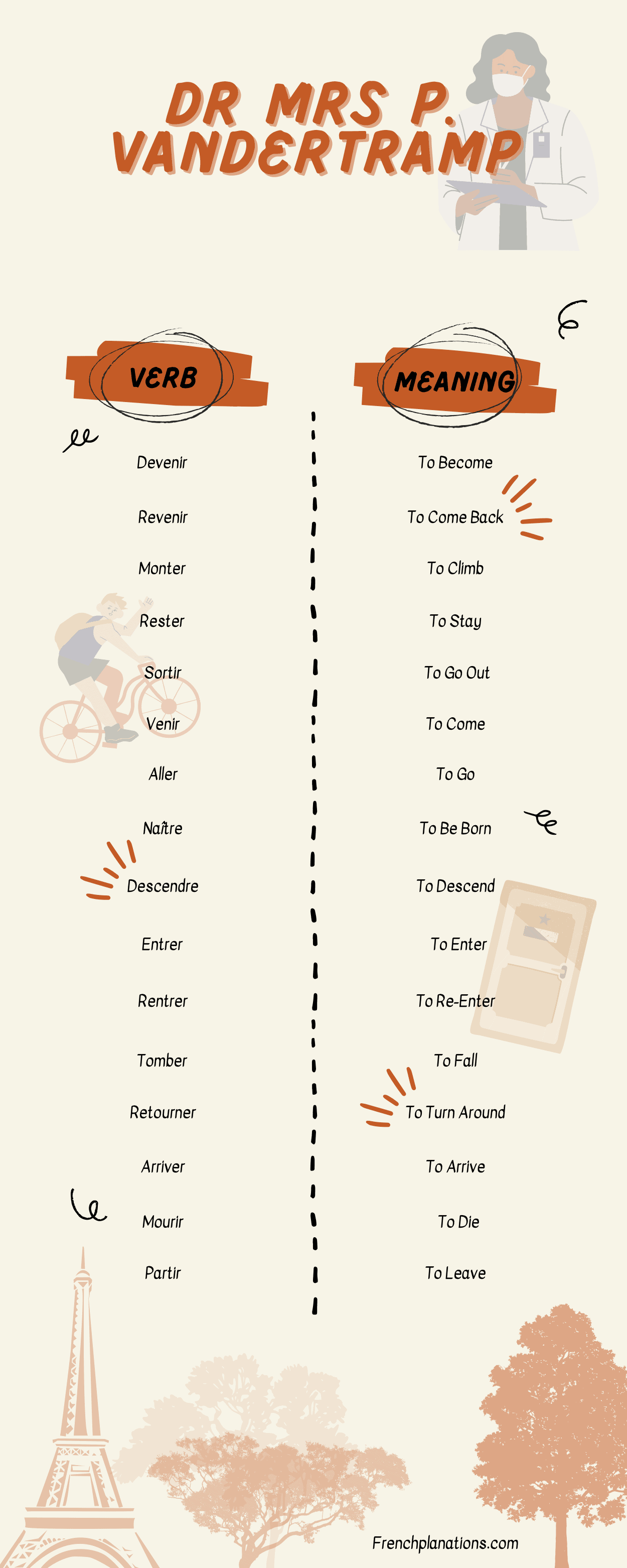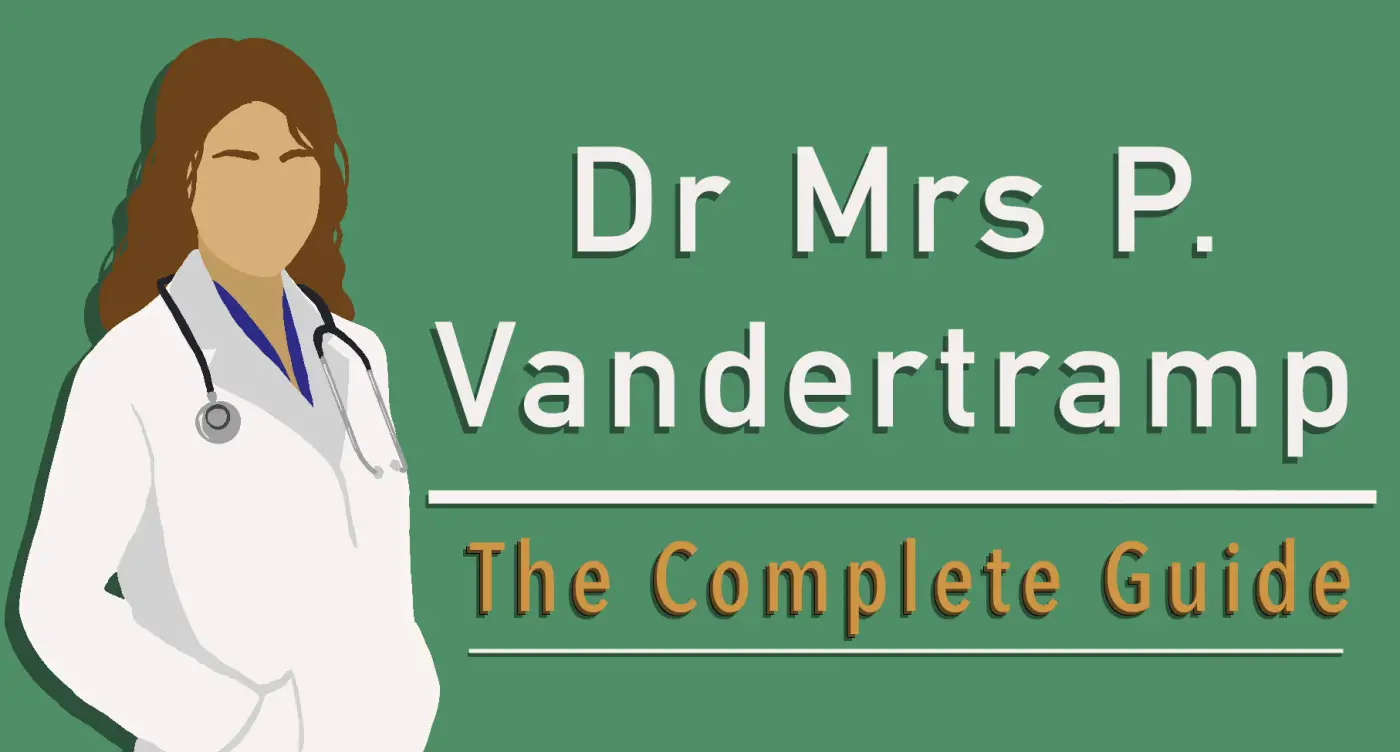French Grammar
DR MRS P. VANDERTRAMP – The Complete Guide
Table of Contents
Dr Mrs. P Vandertramp Audio Lesson
For a deeper explanation on Dr Mrs P. Vandertramp take a few minutes and listen to this article’s audio lesson. You can also download this lesson to listen to later here.
What is DR MRS P. VANDERTRAMP?
Also known as Dr Mrs. Vandertrampp or even La Maison d’Etre, Dr Mrs P. Vandertramp is an acronym that is often taught to French students to help them remember which verbs use « être » as a helping verb when conjugating verbs in the passé composé tense. The Bescherelle Book is a classic guide with references to all verbs in the French language.
This also applies to several other French tenses, but most learners learn about Dr Mrs P. Vandertramp when they first start learning about the passé composé, so let’s just work with that to start.
In the English sentence “I have walked to school” the word walked is in the perfect form of the verb to walk (have walked).
In French the same sentence would read « J’ai marché jusqu’à l’école ».
The j’ai marché (I have walked or I walked) part of this sentence is the verb marcher conjugated in the passé composé.
Here Are The Dr Mrs P. Vandertramp Verbs
Devenir – To Become
Revenir – To Come Back
Monter – To Climb
Rester – To Stay
Sortir – To Go Out
Venir – To Come
Aller – To Go
Naître – To Be Born
Descendre – To Descend
Entrer – To Enter
Rentrer – To Re-Enter
Tomber – To Fall
Retourner – To Turn Around
Arriver – To Arrive
Mourir – To Die
Partir – To Leave
All of these verbs use the auxiliary (or helping) verb être in the past tense instead of the verb avoir. If you want to learn more about être and avoir then check out How to Conjugate The French Verbs Être and Avoir.
The great thing about all of this is that of all the thousands of verbs out there only a handful of them use être (excluding reflexive verbs).
The unfortunate part however is that although these verbs represent only a small percentage of the total verbs in the French language they are used much more often than most other verbs.
If you take the time to memorize this acronym then you’ll have an easy resource to refer to if you are unsure if the verb you’re using requires être or avoir.
Don’t feel like you have to necessarily remember this acronym. If you’d prefer to just remember the verbs on the list then go ahead and do that.
Practice the Dr Mrs P. Vandertramp Verbs
Take a second to practice the Dr Mrs P. Vandertramp verbs. When you feel ready, proceed with the article.
Dr Mrs P. Vandertramp Verbs Infographic
Below is an infographic based on the Dr Mrs P. Vandertramp verbs.

Example Sentences Using the DR MRS P. VANDERTRAMP Verbs
Let’s go over some examples of the DR MRS P. VANDERTRAMP verbs in context…
Il est devenu père à l’âge de 32 ans – He became a father at the age of 32
Je suis revenu à la maison – I came back to the house
Elle est montée dans sa voiture – She got into her car
Nous sommes restés chez nous – We stayed home
Ils sont sortis en boîte hier soir – They went out to the club last night
Il est passé par ici ce matin – He came by here this morning
Tu es venu vers moi – You came to me
Vous êtes allés au magasin – You went to the store
Je suis né en 1982 – I was born in 1982
Nous sommes descendus du bus – We got off the bus
Tu es entré dans ma chambre – You entered my bedroom
Il est rentré en France in Septembre – He went back to France in September
Je suis tombé par terre – I fell on the ground
Vous êtes retournés au Canada – You returned to Canada
Elles sont arrivées en retard – They arrived late
Il est mort vendredi dernier – He died last Friday
Nous sommes partis en vacances – We left on vacation
Don’t forget that when using être you have to make the verb agree with the subject (je, tu, elle, etc..).
What this means is that if the subject is feminine then you have to add an E to the end of the verb ONLY when conjugating the verb into a tense that involves past participle (tombé, entré, arrivé). This includes the passé composé, plus-que-parfait, tutur antérieur, and conditionnel passé.
So if you are a male (or speaking about one) then you would write « Je suis arrivé » whereas if you are a female (or speaking about one) then you would write « Je suis arrivée ».
This also applies if you are talking about objects that are masculine and feminine. Check out our article titled French Genders: Mastering Masculine and Feminine for help on distinguishing masculine from feminine.
If you are talking about something that is plural then you would add an S to the end.
If what you are talking about is both feminine AND plural then you would add both an E and an S (elles sont arrivées).
If you are speaking of a mix of masculine and feminine things then you must use the masculine form.
Here are some examples.
Ils sont arrivés – They arrived (Two or More Men)
Ils sont arrivés – They arrived (Mixture of Men and Women)
Elles sont arrivées – They arrived (Two or More Women)
No matter how many things you’re talking about if it contains at least one masculine subject you need to use the masculine form.
Hopefully by reading this article you’ll have a better idea of which verbs require the use of être instead of avoir.
Comment below and tell us what your favorite tips and tricks are to remember the verbs the use être. Do you use DR MRS P VANDERTRAMP or another system? Explain what it is and how it has helped you.

